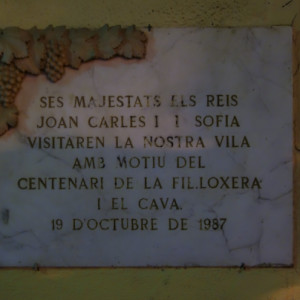"Catalonia is not Spain"
We drove over 800 km today, from Andalucia to Catalonia. Very weary when we arrived in Sant Sadurni d'Anoia at about 8 pm. We hadn't booked anywhere for the night as we weren't sure we'd make it that far, but thanks to a bit of prior research we very efficiently found a room in a hostal round the corner from where we'd parked the car. But then it turned out that inadequate research on my part had landed us in Sant Sadurni on an evening when our favourite restaurant Ticus (the reason we aimed for Sant Sadurni in the first place) was closed. ARGH. However the free wifi in the hostal was great, so I quickly reviewed the other options and found one -- a tapas bar -- that was actually open (it turns out that most places in Sant Sadurni don't bother opening in the evening during the week). Taps de Suro (Corks) is trendily minimalist and serves small plates; we enjoyed a selection of three, plus desserts, along with a bottle of fruity Catalan white. The place was busy, and we were quite impressed that the two staff (one waiter, one chef in the open kitchen/bar area) kept everyone happy despite many of the dishes requiring cooking to order. The service was a bit slow by Spanish standards but perfectly acceptable by our French ones (I normally feel a bit rushed in Spanish restaurants).
Afterwards we wandered down to the Plaça del Ajuntament. This plaque is on the left side of the door of the Town Hall. Translation: "The Spanish flag is displayed on this town hall as a legal requirement". Interpretation: "We are Catalan and we wouldn't fly it otherwise." It clearly wasn't always like this though. The extra shows a plaque on the right side of the door, which reads: "Their Majesties Juan Carlos and Sophia visited our town for the centenary of phylloxera and cava, 19 October 1987". You don't get much more representative of the Spanish state than the monarch.
But hang on: a wine-growing region celebrating the arrival of phylloxera (a vine-destroying bug)? Yep -- Sant Sadurni even has a phylloxera festival every September. When phylloxera arrived in French vineyards in the late 19th century, the Catalans made a killing exporting wine to France. By the time it hit them in turn, a remedy (grafting onto resistant American rootstocks) had been found. They pulled up their afflicted red wine varieties and replaced them with whites, giving a massive boost to cava production. And the rest is history (Sant Sadurni is home to the two biggest producers, Freixenet and Codorniu).


Comments
Sign in or get an account to comment.


